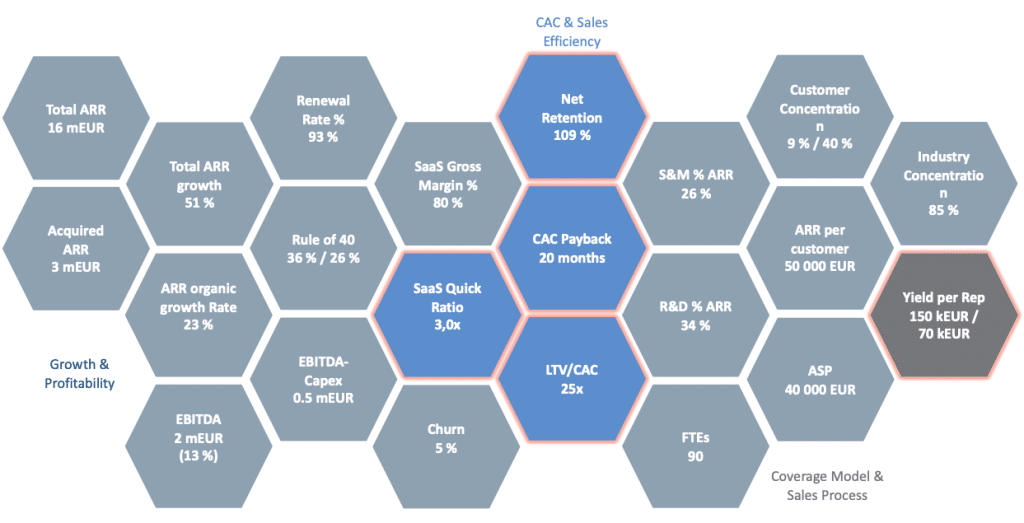How to improve your sales efficiency

How quickly can your sales team convert prospects into leads and, ultimately, paying customers? Sales efficiency measures how good you are at generating revenue within a specific timeframe. Therefore, it is essential for all software businesses to understand, track, and improve. In a previous article, we covered measuring and calculating sales efficiency. Now, we will focus on strategies for improving it.
Understand who your ideal customer is
The first step to improving sales efficiency is understanding your ideal customer profile (ICP).
Imagine you are selling your software only in Europe. There are around 30 million businesses in Europe. If you can pinpoint the 10,000 customers that are a good fit for your company, this could dramatically increase your sales efficiency. With the help of an ICP you can narrow the target list to include companies that are most likely to benefit from your software. Moreover, they are more likely to experience the pain points you are addressing in your marketing. A previous article explains how to create your ideal customer profile in detail.
Match your sales process to your ideal customers’ buying journey
Once you have a clear view of your ICP, it is crucial to target those prospects in an efficient manner. In addition, you should do it in a way that matches their way of buying.
The targeting involves identifying where you could reach your ICPs through digital channels, such as LinkedIn or physical channels, such as trade shows. To do this effectively, leveraging data and analytics is key. Looking at the “lead source” could help determine what channels most often lead to a sale amongst customers with the highest customer lifetime value (CLV).
Complex and multi-staged processes with several decision makers
Tailoring the sales process to the customer’s buying journey is critical in enhancing sales efficiency. B2B buying processes are often complex and multi-staged, involving several decision-makers and influencers. Each stage of this journey, from initial awareness to the final decision, requires a different approach from the sales team. Therefore, it necessitates a sales process that is not only flexible but also empathetic to the customer’s needs.
Use stakeholder mapping to identify key stakeholders and understand their level of interest and decision power for targeted communication. This exercise will give you a high-level view of the entire journey. This overview can help you decide how and when to communicate with different stakeholders.
Align marketing efforts to the buyer’s journey
Aligning your marketing efforts to the buyers’ journey ensures that the messaging and communication strategies resonate with your audience. This alignment helps in crafting compelling narratives that speak directly to the needs and challenges of your potential customers. Thus, increasing engagement and conversion rates.
It’s all about providing consultative, value-added interactions at each step. Ensure that the sales team builds a relationship of trust and credibility. This approach helps close deals more effectively and lays the groundwork for long-term customer relationships.
Measure and track your sales activity
In the quest for sales efficiency, what gets measured gets done. Therefore, establishing and monitoring key performance indicators (KPIs) is paramount. You should carefully choose KPIs to reflect the nuances of B2B sales, encompassing metrics like lead conversion rates, average deal size, yield per rep, customer lifetime value (CLV), customer acquisition costs (CAC), and CAC Payback. CRM and advanced sales analytics tools are indispensable in this context. They provide insights into the ‘what’ and the ‘why’ behind sales performance.
Regularly reviewing these metrics and using them to guide strategic decisions allows your sales teams to become more agile, adapt to market changes, and continuously refine their sales tactics.
See our webinar on 5 KPIs you need to know to measure sales efficiency and how to gain deeper insights here.

Ensure the right incentives are in place
The final piece of the sales efficiency puzzle is ensuring your sales team is motivated and aligned with your company’s broader goals. Crafting incentive programs that strike the right balance between rewarding short-term sales achievements and encouraging long-term customer relationship building would be beneficial. The balance between these two depends on your overall go to market strategy. Incentive structures should be financially rewarding and aligned with career development goals, encouraging sales representatives to not only close deals but also to build expertise in their domain.
Drawing inspiration from case studies of effective incentive models used by similar-sized companies can be particularly instructive. These real-world examples provide tangible ideas for creating incentives that drive performance while maintaining a focus on customer satisfaction and retention.
Conclusion
In summary, successfully increasing sales efficiency involves several aspects. It requires a deep understanding of the ideal customer, a sales process tailored to the customer’s buying journey, rigorous tracking of key metrics, and well-structured incentive programs. By adopting a strategic, data-driven approach and focusing on building lasting customer relationships, these companies can not only enhance their sales efficiency but also establish a strong foothold in your prioritized targets and markets.